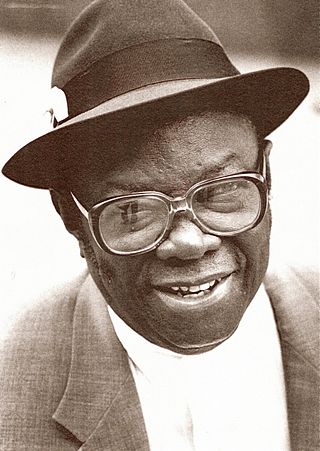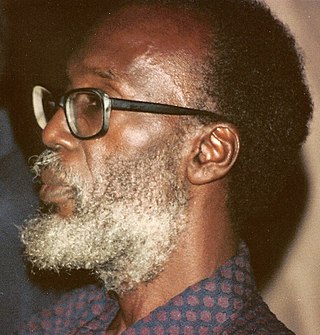"God zij met ons Suriname", or "Opo kondreman", is the national anthem of Suriname. It has two verses: the first in Dutch and the second in Sranan Tongo.
Sranan Tongo is an English-based creole language that is spoken as a lingua franca by approximately 519,600 people in Suriname.

The Aluku are a Bushinengue ethnic group living mainly on the riverbank in Maripasoula in southwest French Guiana. The group are sometimes called Boni, referring to the 18th-century leader, Bokilifu Boni.

The Paramaccan or Paramaka are a Maroon tribe living in the forested interior of Suriname, mainly in the Paramacca resort, and the western border area of French Guiana. The Paramaccan signed a peace treaty in 1872 granting the tribe autonomy.
The Kwinti are a Maroon people, descendants of runaway African slaves, living in the forested interior of Suriname on the bank of the Coppename River, and the eponymous term for their language, which has fewer than 300 speakers. Their language is an English-based creole with Dutch, Portuguese and other influences. It is similar to the languages spoken by the Aluku and Paramaccan Maroons, and split from Sranan Tongo in the middle 18th century. The Kwinti had a population of about 300 in 2014 and adhere to the Moravian Church.

Boy Scouts van Suriname is the national Scouting organization of Suriname. Scouting in Suriname officially started in 1924 and became a member of the World Organization of the Scout Movement (WOSM) in 1968. The coeducational association has 2,601 members.

Henri Frans de Ziel, working under the pen name of Trefossa, was a neoromantic writer in Dutch and Sranan Tongo from Suriname. He is best known for the Sranan Tongo stanzas of Suriname's National Anthem.

Eugène Constantijn Donders Drenthe was a prominent Surinamese poet and playwright.

Surinamese people are people who identify with the country of Suriname. This connection may be residential, legal, historical or cultural. For most Surinamese, several of these connections exist and are collectively the source of their being Surinamese.

Johanna Schouten-Elsenhout was a Surinamese poet and an eminent community leader who fought for acknowledgement of Sranan and of the Afro-Surinamese culture.

Surinamese Maroons are the descendants of enslaved Africans that escaped from the plantations and settled in the inland of Suriname. The Surinamese Maroon culture is one of the best-preserved pieces of cultural heritage outside of Africa. Colonial warfare, land grabs, natural disasters and migration have marked Maroon history. In Suriname six Maroon groups — or tribes — can be distinguished from each other.
NAKS is a social and cultural organization which promotes Afro-Surinamese culture and expression in Suriname and worldwide. The organisation was founded in 1948 with Eugène Drenthe as its first president, when it emerged as the successor of association football club T.O.P. which was founded a year prior.

Diitabiki is a Ndyuka village in the Sipaliwini District of Suriname. Diitabiki is the residence of the gaanman of the Ndyuka people, since 1950, and the location of the oracle.

Eduard Johan "Eddy" Bruma was a Surinamese politician, lawyer and writer.

Julius Gustaaf Arnout Koenders was a Surinamese teacher and fervent activist for Sranan Tongo. As a teacher, he was forced to use the Dutch language thus denying the children their own language. He was an early advocate of Sranan and Creole culture.

Michaël Arnoldus Slory was a Surinamese poet. He mainly wrote poetry in Sranan Tongo, and is considered one of the most important poets in Sranan Tongo. He also published in Dutch, English and Spanish

Dance in Suriname is practiced from the amateur to the professional level for cultural, social and spiritual reasons, among others. Suriname has a variety of traditional and contemporary dance styles which have developed from the cultures of its ethnic groups. In addition, several foreign popular styles have been adopted from the West, the greater Caribbean, Java and Bollywood.

The statue of Kwakoe in the Surinames capital Paramaribo is a monument commemorating the abolition of slavery. It was made by the sculptor Jozef Klas.

Christiaan Hendrik "Hein" Eersel was a Surinamese linguist and cultural researcher.
Guno Hoen was a Surinamese football player, sports journalist, and sports historian. Hoen has played for S.V. Voorwaarts, Politie Voetbal Vereniging, and the Suriname national team. As a footballer, he specialised in penalties and only missed once.















